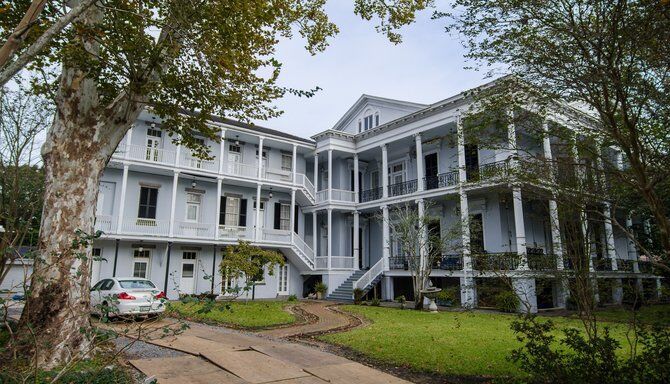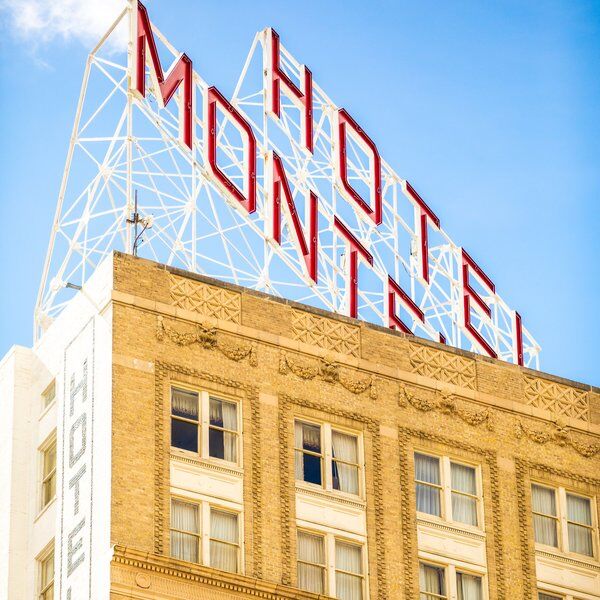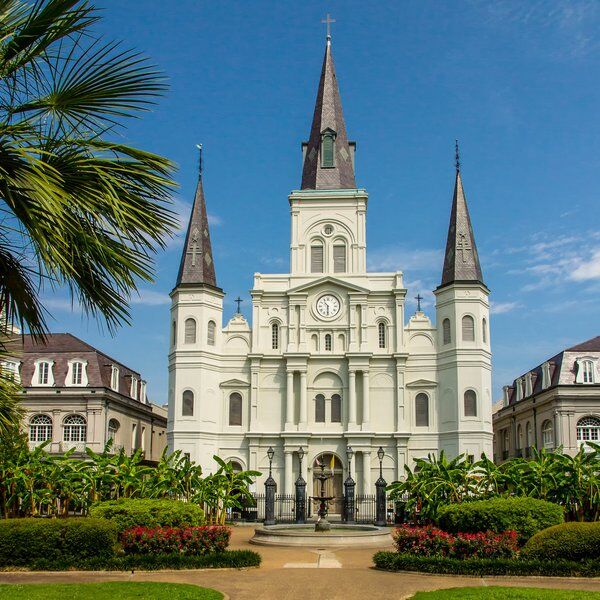Discover Buckner Mansion
Buckner Mansion, in New Orleans’ picturesque Garden District, is a 20,000-square-foot house, built in 1856 by cotton magnate Henry Sullivan Buckner. The mansion is a prime example of Greek Revival architecture; with its grand Corinthian columns, gleaming brass chandeliers, and preserved interiors, it is a window into the opulence of 19th-century Southern aristocracy.
Beyond its appearance, Buckner Mansion is known for the ghost stories that have been passed down through generations and paved the way for its feature in American Horror Story’s ‘Coven’. Today it is considered one of New Orleans’ most haunted landmarks.
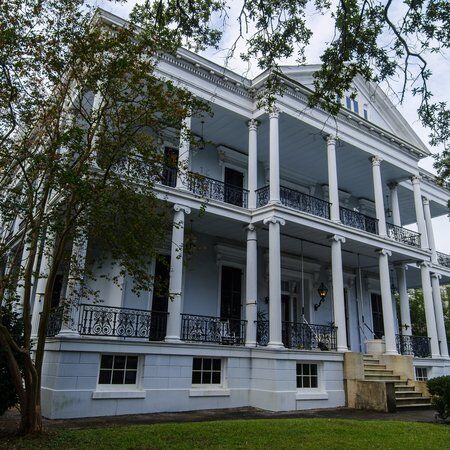
The History of Buckner Mansion
The Vision of a Cotton Baron
In the mid-19th century, the cotton industry was booming, and Henry Sullivan Buckner was one of its wealthiest barons. At a time when New Orleans was one of the wealthiest cities in the United States, Buckner sought to build a home that would reflect his vast fortune. His goal was not just to create a comfortable residence, but to outshine his former business partner, Frederick Stanton, who had constructed the lavish Stanton Hall in Natchez, Mississippi.
Designed by architect Lewis E. Reynolds, Buckner Mansion was completed in 1856. It became one of the grandest homes in New Orleans, set on the prestigious Jackson Avenue—then the main street of Lafayette, an independent city before its annexation into New Orleans.
With 35 rooms, including three ballrooms, and landscaped gardens surrounding the estate, Buckner Mansion was the ultimate symbol of wealth and status. The sprawling grounds included stables and servant quarters, as well as luxurious details that were the pinnacle of 19th-century design.
Becoming the Soule Business School
Following Henry Buckner’s death in 1895, the mansion passed through various owners until 1923, when it was sold and repurposed as the Soule Business School. This transformation marked a new chapter in the mansion’s history, where it became a place of education rather than luxury living.
Soule Business School, an institution that had been established before the Civil War, used Buckner Mansion to teach bookkeeping, shorthand, and secretarial skills. During its 60-year tenure in the mansion, it converted the elaborate ballrooms into classrooms and administrative offices and became renowned for training many of New Orleans’ leading professionals, including Mayor Robert Maestri. Despite the change in function, much of the building's original architectural elements were preserved.
The school operated at Buckner Mansion until 1983, when it was once again returned to private ownership. Today, a poetic inscription in the sidewalk outside still honors this period: “From education as the leading cause, the public character its color draws.”
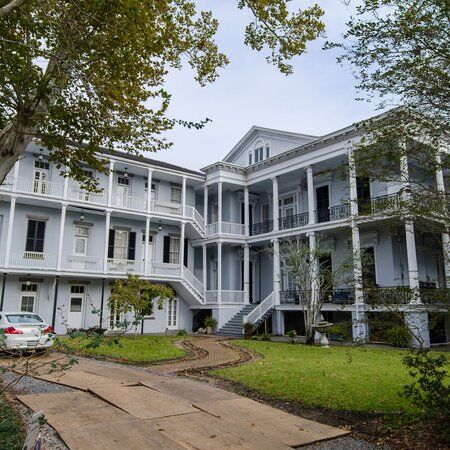
The Architecture and Features of Buckner Mansion
Greek Revival Splendor
Buckner Mansion is one of the most iconic examples of Greek Revival architecture in New Orleans. Greek Revival became a dominant style in the American South in the 19th century. Buckner Mansion exemplifies this with its two-story portico supported by 48 fluted Ionic and Corinthian columns.
These towering columns, which wrap around three sides of the house, are a hallmark of the Greek Revival style, reflecting symmetry from every angle and evoking the grandeur of classical Greek temples. Adding to the estate’s sense of refinement and exclusivity is a cast-iron fence, which surrounds the half-acre of gardens and features a rare honeysuckle design.
Interior Design
The interior of Buckner Mansion is equally as impressive as its exterior. Stepping inside, visitors are greeted by a grand staircase, 16-foot ceilings, and floor-to-ceiling windows, which flood the spacious rooms with natural light.
The mansion's three ballrooms, which were originally used for large social gatherings and parties, are connected by a series of rooms and dotted with intricate crown moldings, plasterwork, and marble fireplaces, along with brass chandeliers that have been meticulously preserved. The mansion also has a detached two-car garage, a modern addition that contrasts with the historical architecture.
Restorations and Modern Use
Since the closure of the Soule Business School, Buckner Mansion has undergone several restoration projects to return it to its original splendor. Significant renovations were undertaken in the 1990s by new owners, who sought to modernize the mansion while maintaining its historical charm.
Sandra and Norman King began the restoration, followed by Susan and Charles Zambito, who purchased the property in 1997 and completed the renovation efforts. Historical elements that were preserved included the original hardwood floors, fluted cypress columns, and intricate wrought-iron railings.
Today, the mansion, with modern plumbing, updated electrical systems, and renovated kitchens and baths, is a private rental property and a highly sought-after venue for weddings, film productions, and other private events.
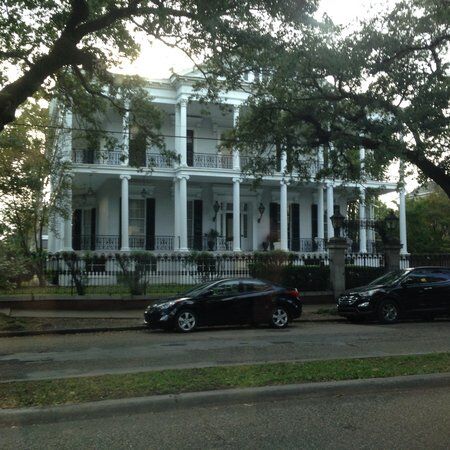
Miss Josephine: The Guardian of Buckner Mansion
One figure tied to Buckner Mansion is Miss Josephine Nicaud, a former servant turned free woman of color, who lived and worked at the mansion. Josephine was not simply a domestic worker—she was the head of the household staff, managing the day-to-day operations of the mansion with precision and care. She was deeply loyal to the Buckner family, and it would seem, her dedication extended beyond her death.
According to local legend, Miss Josephine vowed to never leave the mansion, even after her death. It is said that she continues to watch over the home and its occupants to this day. Visitors, tenants, and caretakers have reported strange occurrences believed to be linked to her spirit.
Some claim to have heard the sound of sweeping on the front porch—a task that Josephine was known to do often—while others have detected the faint smell of lemon—reportedly her favorite fragrance—wafting through the air. Some even claim to have seen her apparition standing at the top of the grand staircase, watching over the house as she did in life.
For many, Josephine’s spirit is considered more of a guardian than a ghost, and her presence is felt as a protective force rather than something malevolent. Her story reminds visitors of the many lives—both wealthy and working-class—that have resided at Buckner Mansion.
American Horror Story: Coven and Buckner Mansion
In 2013, Buckner Mansion achieved international fame when it became the exterior filming location for Miss Robichaux’s Academy for Exceptional Young Ladies in American Horror Story: Coven. Coven is the third season of Ryan Murphy’s hit horror series and follows a group of witches living in New Orleans. The mansion served as the boarding school for these witches, who come to New Orleans to learn how to control their powers under the guidance of the Supreme witch.
The mansion's imposing columns, grand balconies, and eerie historical ambiance made it the perfect backdrop for the show’s supernatural storyline. Its haunting exterior helped create a sense of mystery and danger, which played into the season's themes of witchcraft, voodoo, and power struggles. American Horror Story: Coven was a massive success, earning numerous Primetime Emmy and Golden Globe nominations, and turning Buckner Mansion into a must-see destination for fans of the show.
The mansion’s appearance in Coven elevated its status from a local historical gem to a globally recognized pop culture icon. Today, fans of the show continue to visit the mansion, snapping photos and reliving their favorite moments from the series.

Paranormal Activity at Buckner Mansion
Beyond its role in pop culture, Buckner Mansion is famous for its paranormal activity. The most well-known ghost is, of course, Miss Josephine, whose spirit is believed to linger in the mansion. But in addition to Josephine’s ghost, other strange phenomena have been reported throughout the mansion.
Flickering lights, swaying chandeliers, and doors that open and close on their own are common occurrences. Some visitors have even experienced cold drafts in rooms with no windows open, or the sound of footsteps echoing through the empty halls. The combination of Buckner Mansion’s haunted reputation and its eerie appearance in American Horror Story has made it a magnet for ghost hunters and paranormal enthusiasts.
Explore Beyond Buckner Mansion with CityDays
While Buckner Mansion offers a glimpse into New Orleans’ haunted history, the city is filled with other fascinating sites that blend history and the supernatural.
And the best way to discover more hidden gems around New Orleans is to take your time and, ideally, have a pre-planned route that takes you past all the noteworthy nooks and hidden gems.
We can help you there!
CityDays combines the fun of an outdoor treasure hunt with the historic facts and whimsical trivia of a walking tour.
Answer riddles, solve puzzles and learn more about London’s 2000-year-old history in a new and interactive way - plus you get 20% off food and drink at a historic pub chosen by us!
Take the stress out of planning your visit to New Orleans and book your adventure today!
Not visiting New Orleans this time? Don’t worry, you’ll find us all over the world.
